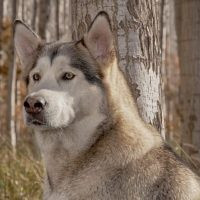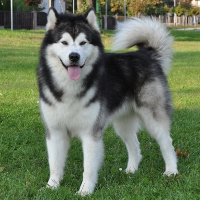Appearance of the Mally Foxhound
|
| The Mally Foxhound is a hybrid of the Alaskan Malamute and the English Foxhound. As such, the hybrid can take on the appearance traits of one or both parent breeds. Your hybrid may have a broad, muscular body with confident posture, or an athletic, clean-cut, muscular body without bulk; a broad head with pointed ears carried erect, or a long muzzle with hanging, low-set ears of medium length; dark eyes with eye rims, nose and lips all black; or large brown eyes; the tail could be long and curved back, or long and gaily carried high. The colors of the hybrid could be: a variety of colors ranging from solid white to bicolor white with black, gray, red or sandy markings or tricolor (black, white and tan) or white with hare (more tan than black and white, giving the appearance of a hare), badger (mix of white, gray, brown and black hairs), fawn or yellow. The coat can be double, with the undercoat around 5 centimeters long, thick and oily to provide protection against cold temperatures and repel water, or short, glossy, hard-textured and dense. The hybrid could weigh from 25 to 43 kilos and measure 56 to 69 centimeters. |
Temperament of the Mally Foxhound
|
| Your Mally Foxhound hybrid can take on the temperament qualities of one or both of its parent breeds. Your hybrid may behave like a big puppy for most of its life, enjoying romping and playing with human family members as much as the professional tasks it was bred for. Both parent breeds have seemingly endless reserves of energy and friendliness, and are easy-going enough to allow them to adapt to most living environments. Your hybrid will probably be good with children and strangers, but probably not so much with cats and other animals. Both parent breeds have a strong hunting instinct and an impulse to wander, so it's important to remember to keep your hybrid on a leash whenever you're out of the house and outside the fenced yard, that is, unless you enjoy chasing your hybrid as it follows that interesting scent wherever it leads, over hill or dale. The parent breeds have been described as affectionate, aggressive, friendly, gentle, independent, loyal, playful, calm and social. They make excellent pets. |
Needs and activities of the Mally Foxhound
|
| Your Mally Foxhound is a very active dog. He'll need plenty of exercise to stay healthy and fit. You should expect to exercise your hybrid about 1-2 hours a day and this can be accomplished in the form of long walks or jogs with your dog, playtime in the dog park or fenced yard as well as games of Frisbee and fetch. You'll need to keep your Mally Foxhound mentally challenged to avoid the annoying destructive habits that can result from boredom. Agility and obedience training and land dog training can help in this area. The high activity level of this hybrid will somewhat prevent it from living in apartments or condos, unless the owner is dedicated to devoting time and energy to keeping it appropriately challenged physically and mentally, activities that will have to be carried out outside the apartment. or condominium. He'll do much better in a house with a fenced yard, and can live in a rural or urban setting. Depending on the density of your hybrid's coat, it will probably be better suited to cooler climates than warmer ones. |
Maintenance of the Mally Foxhound
|
| The Mally Foxhound is a hybrid dog considered to be in the low-to-moderate maintenance category. The length and density of the coat will determine how often your hybrid needs to be brushed and bathed. If the coat qualities come from the Malamute side, you'll need to brush two to three times a week, especially during periods of heavy shedding, but if the coat comes from the Foxhound side, a weekly brushing with a dog glove should be sufficient, as this breed sheds slightly all year round. Bathing should only be done when necessary when your hybrid is dirty or starting to smell, to avoid stripping the coat of the essential oils it needs. Paying attention to the ears at least once a week, checking and cleaning as needed, and brushing his teeth daily or at least two or three times a week will reduce the risk of periodontal disease leading to tooth loss over time. Toenails should be trimmed periodically unless the dog wears them down through normal physical activity. Follow these regular eye and physical examinations to keep your hybrid healthy and fit. |









 English (United Kingdom)
English (United Kingdom)